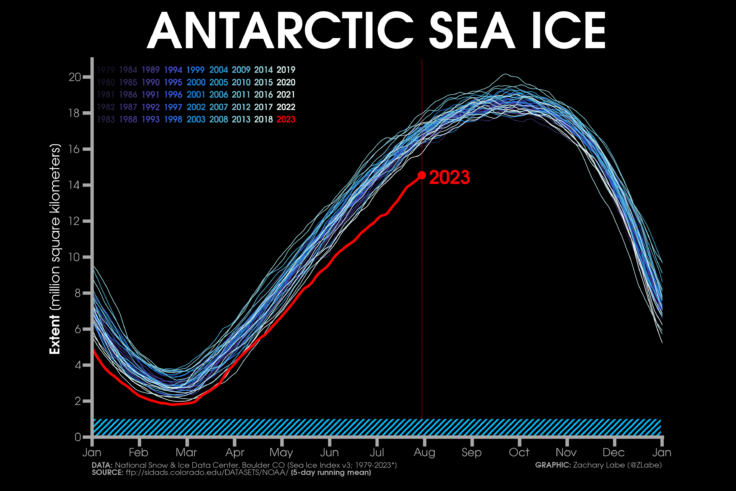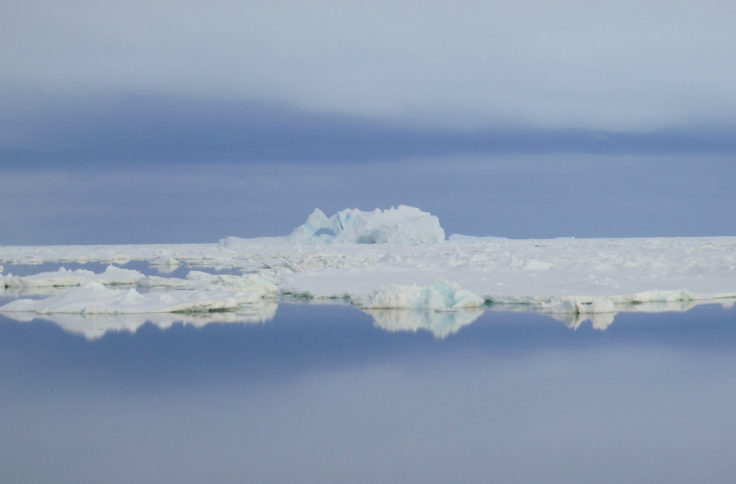The mystery of the missing Antarctic sea ice
Winter sea ice in the Antarctic is at a historic low, and scientists are working to understand why an area of ice the size of Greenland is missing. Scientists from British Antarctic Survey have been active in the media offering commentary on this extreme event.
Sea ice is frozen ocean water that forms and melts entirely in the ocean, and it has a natural pattern of growth and reduction that has been monitored by satellites for 44 years. This data gives scientists a detailed picture of the area that sea ice covers surrounding the continent of Antarctica, known as the sea ice ‘extent’.
Antarctic sea ice has been quite stable in its average extent over that period – until 2016, when it began to decline. Since 2016, there have been seen several record summer lows, with Antarctic summers 2021/22 and 2022/23 setting new sea ice minimas.
At the start of August 2023, the depths of Antarctic winter, deviation from all previous records has intensified. As of August 2023, the sea ice extent is almost 2.4 million km2 lower than the 1979-2022 average – a missing area around ten times the size of the UK.

Dr Caroline Holmes, polar climate scientist at BAS and part of the DEFIANT project, which is investigating sea ice around the Weddell Sea in Antarctica, says:
“Right now, in August 2023, the sea ice extent in Antarctica is still far below all previous records for this time of year. In this period where oceans are freezing up, we’re seeing areas that are still, remarkably, largely ice-free – such as the northern bounds of the sea ice away from the coast, the coast of the eastern Bellingshausen Sea and west of the peninsula.”
What’s causing the 2023 sea ice anomaly?
Climate models have always led us believe that Antarctic sea ice would reduce as a result of human-induced warming. However, the current change to sea-ice extent is dramatic, and has led scientists to question what mechanisms can explain it. However, Antarctic sea ice is very complicated to model accurately because it is affected by so many of Earth’s natural processes.
Dr Caroline Holmes continues:
“Wind patterns, storms, ocean currents and air and ocean temperatures all affect how much of the sea around Antarctica is covered by ice, and they often push and pull in different directions. This means it can be hard to link the behaviour of Antarctic sea ice in any particular year, or over several years, to just one factor.
“Before 2015, contrasting trends in sea ice growth in different regions of the vast continent mostly counterbalanced each other. What’s remarkable about 2023 is that these regional differences are largely absent.”
Natural atmospheric patterns that affect sea ice include the El Niño-Southern Oscillation, the strength of the southern hemisphere jet stream, and regional low-pressure systems. For instance, sea ice in Antarctica reached record lows in the Antarctic summer 2022/23, driven by very anomalous atmospheric circulation, which scientists say could be natural and associated with the triple La Niña of the last few years. Meanwhile, climate change can drive the extremes of natural events to greater levels with each cycle, making it even harder for scientists to judge how much current extremes are due to human-induced global warming.
BAS polar oceanographer, Andrew Meijers, who is the UK lead on an EU project called OCEAN:ICE, explains:
“Many climate scientists will be viewing the period since 2016 as the real world catching up to the models – that climate change has finally ‘burned through’ the natural barriers around the sea ice formed by the unique wind and atmospheric circulation, which insulates the continent to a significant extent.
“We don’t have a lot of concreted evidence to actually support this view, because the actual mechanism of change is very unclear: some are arguing for atmospheric drivers, some for the ocean. I suspect some sort of coupled response between both, with extra complications added by increased glacial melt into the upper ocean from the Antarctic ice sheet.”
Why does sea ice matter?

Regardless of the degree to which the current anomaly in Antarctic sea ice is due to human-induced warming, this extreme event demands urgent scientific attention.
Dr Ella Gilbert, climate scientist at British Antarctic Survey, says:
“Antarctic sea ice varies a lot year-to-year, but even by Antarctic standards this is well outside the bounds of normality.
“Given how complex a system it is, we can’t say conclusively whether the past 40 years (the period for which we have satellite observations) are an accurate reflection of the “natural” behaviour of Antarctic sea ice. While seven days may be a long time in politics, seven years is a short time when it comes to the climate. It is too early to say conclusively whether the recent dramatic fall in Antarctic sea ice extent is simply a blip in the record or, as now seems more likely, the first sign of a longer-lasting reduction induced by climate change.
“Regardless of the vagaries of Antarctic sea ice behaviour, the polar regions play a vital role in the climate system. And they are changing before our very eyes.”
Sea ice plays an important stabilising role in the Antarctic. It covers a vast area of the dark sea with a bright white surface that reflects the sun’s energy back into space – known as the Albedo effect – helping reduce temperatures at the poles. Research also suggests that Antarctic sea ice protects glacial ice shelves from ocean swells.
Andrew Meijers, continues:
“As the ocean circulation around Antarctica has a hugely disproportionate impact on global heat and carbon distribution between the ocean and atmosphere, as well as driving sea level rise via ice sheet melt and supplying nutrients to much of the worlds oceans, we should be very concerned and attentive to such massive changes as we are seeing now.
“There is a desperate need for more observations in the region, particularly in winter and under the sea ice and ice shelves, to really understand how the system works and how it is changing.”
This article is based on comment from British Antarctic Survey scientists in the media, including:
- Antarctica is missing a chunk of sea ice bigger than Greenland – what’s going on? (theconversation.com)
- Is the climate crisis finally catching up with Antarctica? Finding the answer has never been more pressing | Andrew Meijers | The Guardian
- The rapid loss of Antarctic sea ice brings grim scenarios into view (economist.com)
- World at One – 03/08/2023 – BBC Sounds (from 31.17)
- ‘Something weird is going on’: search for answers as Antarctic sea ice stays at historic lows | Antarctica | The Guardian
- Antarctica sees one in 7.5 million year event as ice levels plummet (yahoo.com)
- Missing ice and bleached coral: the sudden warming of the oceans | Financial Times